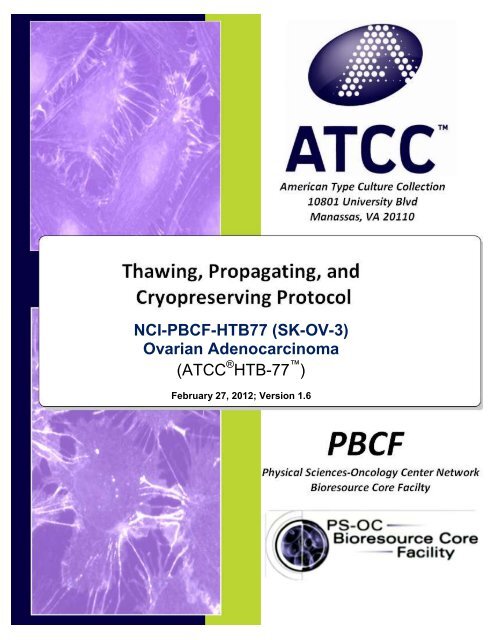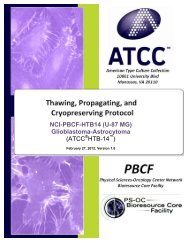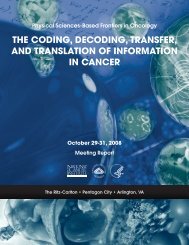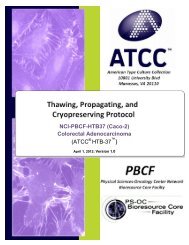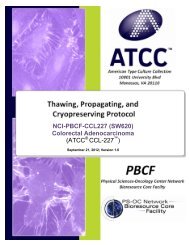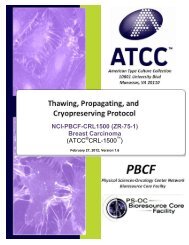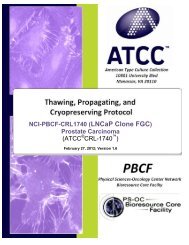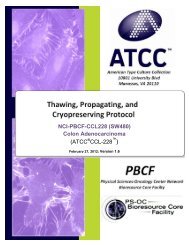SK-OV-3
SK-OV-3
SK-OV-3
You also want an ePaper? Increase the reach of your titles
YUMPU automatically turns print PDFs into web optimized ePapers that Google loves.
NCI-PBCF-HTB77 (<strong>SK</strong>-<strong>OV</strong>-3)Ovarian Adenocarcinoma(ATCC ® HTB-77 )February 27, 2012; Version 1.6
Table of Contents1. BACKGROUND INFORMATION ON <strong>SK</strong>-<strong>OV</strong>-3 CELL LINE ......................................................... 3 2. GENERAL INFORMATION FOR THE THAWING, PROPAGATING AND CRYOPRESERVINGOF NCI-PBCF-HTB77 (<strong>SK</strong>-<strong>OV</strong>-3) .......................................................................................................... 3 3. REAGENTS .................................................................................................................................... 5 MCCOY’S 5A MEDIUM MODIFIED, ...................................................................................................... 5 MCCOY’S 5A MEDIUM MODIFIED, ...................................................................................................... 5 A. PREPARATION OF COMPLETE GROWTH MEDIUM (MCCOY’S 5A + 10 % (V/V) FBS) ............................ 5 4. THAWING AND PROPAGATION OF CELLS ............................................................................... 6 A. THAWING CELLS ............................................................................................................................ 6 B. PROPAGATING CELLS .................................................................................................................... 7 C. SUBCULTURING CELLS ................................................................................................................... 8 5. HARVESTING OF CELLS FOR CRYOPRESERVATION ............................................................. 9 6. CRYOPRESERVATION OF CELLS ............................................................................................ 11A. CRYOPRESERVATION USING A RATE-CONTROLLED PROGRAMMABLE FREEZER ................................ 11i. Using the Cryomed ............................................................................................................... 11B. CRYOPRESERVATION USING “MR. FROSTY” .................................................................................. 127. STORAGE .................................................................................................................................... 13APPENDIX 1: PHOTOMICROGRAPHS OF NCI-PBCF-HTB77 (<strong>SK</strong>-<strong>OV</strong>-3) CELLS. ........................ 14APPENDIX 2: GROWTH PROFILE OF NCI-PBCF-HTB77 (<strong>SK</strong>-<strong>OV</strong>-3) CELLS ................................ 16APPENDIX 3: CYTOGENETIC ANALYSIS OF NCI-PBCF-HTB77 (<strong>SK</strong>-<strong>OV</strong>-3) CELLS .................... 17APPENDIX 4: GLOSSARY OF TERMS ............................................................................................. 21APPENDIX 5: REFERENCE ............................................................................................................... 22APPENDIX 6: REAGENT LOT TRACEABILITY AND CELL EXPANSION TABLES ...................... 23APPENDIX 7: CALCULATION OF POPULATION DOUBLING LEVEL (PDL) ................................ 25APPENDIX 8: SAFETY PRECAUTIONS ........................................................................................... 25
SOP: Thawing, Propagating and Cryopreserving of NCI-PBCF-HTB77 (<strong>SK</strong>-<strong>OV</strong>-3)Protocol for Thawing, Propagating and Cryopreserving ofNCI-PBCF-HTB77 (<strong>SK</strong>-<strong>OV</strong>-3; ATCC ® HTB-77 ) cellsovarian adenocarcinoma1. Background Information on <strong>SK</strong>-<strong>OV</strong>-3 cell lineDesignations:<strong>SK</strong>-<strong>OV</strong>-3 [<strong>SK</strong><strong>OV</strong>-3]Biosafety Level: 1Shipped:frozen (in dry ice)Growth Properties: adherent (see Appendix 1)Organism:Homo sapiensOrganSource:DiseaseDerived from metastaticsite:ovaryadenocarcinomaascitesFor more information visit the ATCC webpage:http://www.atcc.org/ATCCAdvancedCatalogSearch/ProductDetails/tabid/452/Default.aspx?ATCCNum=HTB-77&Template=cellBiology2. General Information for the thawing, propagating andcryopreserving of NCI-PBCF-HTB77 (<strong>SK</strong>-<strong>OV</strong>-3)Culture InitiationComplete GrowthMediumCell GrowthThe cryoprotectant (DMSO) should be removed by centrifugation.The seeding density to use with a vial of <strong>SK</strong>-<strong>OV</strong>-3 cells is about 4 x 10 4 viablecells/cm 2 or one vial into a T-25 flask containing 10 mL complete growth medium(McCoy’s 5a + 10 % (v/v) FBS).The complete growth medium used to expand <strong>SK</strong>-<strong>OV</strong>-3 cells is McCoy’s 5a + 10% (v/v) FBS.Complete growth medium (McCoy’s 5a + 10 % (v/v) FBS) should be pre-warmedbefore use by placing into a water bath set at 35 o C to 37 o C for 15 min to 30 min.After 30 min, the complete growth medium (McCoy’s 5a + 10 % (v/v) FBS) shouldbe moved to room temperature until used. Complete growth medium (McCoy’s 5a+ 10 % (v/v) FBS) should be stored at 2 o C to 8 o C when not in use.The growth temperature for <strong>SK</strong>-<strong>OV</strong>-3 is 37 o C ± 1 o C.A 5 % + 1 % CO 2 in air atmosphere is recommended.Growth Properties Population doubling time (PDT) is approximately 35 h (Figure 4).Special GrowthRequirementsSubculture <strong>SK</strong>-<strong>OV</strong>-3 cells at 80 % to 90 % confluence or when cell densityreaches an average of 1.4 x 10 5 viable cells/cm 2 .Page 3 of 25
SOP: Thawing, Propagating and Cryopreserving of NCI-PBCF-HTB77 (<strong>SK</strong>-<strong>OV</strong>-3)Subculture MediumSubculture MethodViableCells/mL/CryovialCryopreservationMedium0.25 % (w/v) trypsin-0.53 mM EDTA (ATCC cat. no. 30-2101).Subculturing reagents should be pre-warmed before use by placing into a waterbath set at 35 o C to 37 o C for 15 min to 30 min.After 30 min, the subculturing medium should be moved to room temperatureuntil used. Subculturing reagents should be stored at 2 o C to 8 o C when not inuse.The attached <strong>SK</strong>-<strong>OV</strong>-3 cells are subcultured using 0.25 % (w/v) trypsin-0.53 mMEDTA (ATCC cat no. 30-2101).The enzymatic action of the trypsin-EDTA is stopped by adding complete growthmedium to the detached cells.A split ratio of 1:4 to 1:5 or a seeding density 3 x 10 4 to 3.75 x 10 4 viablecells/cm 2 is used when subculturing <strong>SK</strong>-<strong>OV</strong>-3 cells.The target number of viable cells/mL/cryovial is: 1 x 10 6 (acceptable range: 1 x10 6 viable cells/mL to 2 x 10 6 viable cells/mL).The cryopreservation medium for <strong>SK</strong>-<strong>OV</strong>-3 cells is complete growth medium(McCoy’s 5a + 10 % (v/v) FBS) containing 5 % (v/v) DMSO (ATCC cat no. 4-X).General Procedure to be applied throughout the SOPAseptic TechniqueTraceability ofmaterial/reagentsExpansion of cell lineUse of good aseptic technique is critical. Any materials that are contaminated, aswell as any materials with which they may have come into contact, must bedisposed of immediately.Record the manufacturer, catalog number, lot number, date received, dateexpired and any other pertinent information for all materials and reagents used.Record information in the Reagent Lot Traceability Table 4 (Appendix 6).Record the subculture and growth expansion activities, such as passage number,% confluence, % viability, cell morphology (see Figures 1, 2, 3, Appendix 1) andpopulation doubling levels (PDLs), in the table for Cell Expansion (Table 5,Appendix 6). Calculate PDLs using the equation in Appendix 7.Medium volumes Medium volumes are based on the flask size as outlined in Table 1.Glossary of Terms Refer to Glossary of Terms used throughout the document (see Appendix 4).Safety PrecautionRefer to Safety Precautions pertaining to the thawing, propagating andcryopreserving of <strong>SK</strong>-<strong>OV</strong>-3 (see Appendix 8).Page 4 of 25
SOP: Thawing, Propagating and Cryopreserving of NCI-PBCF-HTB77 (<strong>SK</strong>-<strong>OV</strong>-3)Table 1: Medium VolumesFlask SizeMedium Volume Range12.5 cm 2 (T-12.5) 3 mL to 6 mL25 cm 2 (T-25) 5 mL to 13 mL75 cm 2 (T-75) 10 mL to 38 mL150 cm 2 (T-150) 30 mL to 75 mL175 cm 2 (T-175) 35 mL to 88 mL225 cm 2 (T-225) 45 mL to 113 mL3. ReagentsFollow Product Information Sheet storage and/or thawing instructions. Below is a list ofreagents for the propagation, subcultivation and cryopreservation of <strong>SK</strong>-<strong>OV</strong>-3 cells.Table 2: Reagents for Expanding, Subculturing and Cryopreservingof <strong>SK</strong>-<strong>OV</strong>-3 cellsComplete growth mediumreagentsMcCoy’s 5a Medium Modified,(ATCC cat no. 30-2007)10 % (v/v) Fetal Bovine Serum(FBS)(ATCC cat no. 30-2020)Subculturing reagentsTrypsin-EDTA (0.25 % (w/v)Trypsin/0.53 mM EDTA )(ATCC cat no. 30-2101)Dulbecco’s Phosphate BufferedSaline (DPBS); modified withoutcalcium chloride and withoutmagnesium chloride(ATCC cat no. 30-2200)Cryopreservation mediumreagentsMcCoy’s 5a Medium Modified,(ATCC cat no. 30-2007)10 % (v/v) FBS(ATCC cat no. 30-2020)5 % (v/v) Dimethyl Sulfoxide(DMSO)(ATCC cat no. 4-X)a. Preparation of complete growth medium (McCoy’s 5a + 10 %(v/v) FBS)The complete growth medium is prepared by aseptically combining,1. 56 mL FBS (ATCC cat no. 30-2020) to a 500 mL bottle of basal medium – McCoy’s5a (ATCC cat no. 30-2007).2. Mix gently, by swirling.Page 5 of 25
SOP: Thawing, Propagating and Cryopreserving of NCI-PBCF-HTB77 (<strong>SK</strong>-<strong>OV</strong>-3)4. Thawing and Propagation of CellsReagents and Material:Complete growth medium (McCoy’s 5a + 10 % (v/v) FBS)Water bathT-25 cm 2 polystyrene flask 15 mL polypropylene conical centrifuge tubesPlastic pipettes (1 mL,10 mL, 25 mL)a. Thawing cellsMethod:1. Place complete growth medium (McCoy’s 5a + 10 % (v/v) FBS) in a water bath set at35 o C to 37 o C.2. Label T-25 flask to be used with the (a) name of cell line, (b) passage number, (c)date, (d) initials of technician.3. Wearing a full face shield, retrieve a vial of frozen cells from vapor phase of the liquidnitrogen freezer.4. Thaw the vial by gentle agitation in a water bath set at 35 o C to 37 o C. To reduce thepossibility of contamination, keep the O-ring and cap out of the water.Note: Thawing should be rapid (approximately 2 min to 3 min, just long enoughfor most of the ice to melt).5. Remove vial from the water bath and process immediately.6. Remove excess water from the vial by wiping with sterile gauze saturated with 70 %ethanol.7. Transfer the vial to a BSL-2 laminar-flow hood.Page 6 of 25
SOP: Thawing, Propagating and Cryopreserving of NCI-PBCF-HTB77 (<strong>SK</strong>-<strong>OV</strong>-3)b. Propagating cellsMethod:1. Add 9 mL of complete growth medium (McCoy’s 5a + 10 % (v/v) FBS) to a 15-mLconical centrifuge tube.2. Again wipe the outer surface of the vial with sterile gauze wetted with 70 % ethanol.3. Using sterile gauze, carefully remove the cap from the vial.4. With a 1 mL pipette transfer slowly the completely thawed content of the vial (1 mLcell suspension) to the 15-mL conical centrifuge tube containing 9 mL completegrowth medium (McCoy’s 5a + 10 % (v/v) FBS). Gently resuspend cells by pipettingup and down.5. Centrifuge at 125 xg, at room temperature, for 8 min to 10 min.6. Carefully aspirate (discard) the medium, leaving the pellet undisturbed.7. Using a 10 mL pipette, add 10 mL of complete growth medium (McCoy’s 5a + 10 %(v/v) FBS).8. Resuspend pellet by gentle pipetting up and down.9. Using a 1 mL pipette, remove 1 mL of cell suspension for cell count and viability. Cellcounts are performed using either an automated counter (such as Innovatis CedexSystem; Beckman-Coulter ViCell system) or a hemocytometer.10. Record total cell count and viability. When an automated system is used, attachcopies of the printed results to the record.11. Plate cells in pre-labeled T-25 cm 2 flask at about 4 x 10 4 viable cells/cm 2 .12. Transfer flask to a 37 °C ± 1 °C in 5 % CO 2 incubator if using flasks with vented caps(for non-vented caps stream 5 % CO 2 in the headspace of flask).13. Observe culture daily by eye and under an inverted microscope to ensure culture isfree of contamination and culture has not reached confluence. Monitor, visually, thepH of the medium daily. If the medium goes from red through orange to yellow,change the medium.14. Note: In most cases, cultures at a high cell density exhaust the medium fasterthan those at low cell density as is evident from the change in pH. A drop inpH is usually accompanied by an increase in cell density, which is an indicatorto subculture the cells. Cells may stop growing when the pH is between pH 7to pH 6 and loose viability between pH 6.5 and pH 6.15. If fluid renewal is needed, aseptically aspirate the complete growth medium from theflask and discard. Add an equivalent volume of fresh complete growth medium tothe flask. Alternatively, perform a fluid addition by adding fresh complete growthmedium to the flask without removing the existing medium. Record fluid change orfluid addition on the Cell Line Expansion Table (see Table 5 in Appendix 6).Page 7 of 25
SOP: Thawing, Propagating and Cryopreserving of NCI-PBCF-HTB77 (<strong>SK</strong>-<strong>OV</strong>-3)16. If subculturing of cells is needed, continue to ‘Subculturing cells’.Note: Subculture when cells are 80-90 % confluent (see photomicrographs inAppendix 1) or when cell density reaches an average of 1.4 x 10 5 viablecells/cm 2 .c. Subculturing cellsReagents and Material:0.25 % (w/v) Trypsin-0.53 mM EDTADPBSComplete growth medium (McCoy’s 5a (ATCC cat no. 30-2007) + 10 % (v/v) FBS(ATCC cat no. 30-2020)Plastic pipettes (1 mL, 10 mL, 25 mL)T-75 cm 2 , T-225 cm 2 polystyrene flasksMethod:1. Aseptically remove medium from the flask2. Add appropriate volumes of sterile Ca 2+ - and Mg 2+ -free DPBS to the side of the flaskopposite the cells so as to avoid dislodging the cells (see Table 3).3. Rinse the cells with DPBS (using a gently rocking motion) and discard.4. Add appropriate volume of 0.25 % Trypsin-0.53 mM EDTA solution to the flask (seeTable 3).5. Incubate the flask at 37 o C ± 1 °C until the cells round up. Observe cells under aninverted microscope every 5 min. When the flask is tilted, the attached cells shouldslide down the surface. This usually occurs after 5 min to 10 min of incubation.Note: Do not leave trypsin-EDTA on the cells any longer than necessary asclumping may result.6. Neutralize the trypsin-EDTA/cell suspension by adding an equal volume of completegrowth medium (McCoy’s 5a + 10 % (v/v) FBS) to each flask. Disperse the cells bypipetting, gently, over the surface of the monolayer. Pipette the cell suspension upand down with the tip of the pipette resting on the bottom corner or edge until asingle cell suspension is obtained. Care should be taken to avoid the creation offoam.7. Using a 1 mL pipette, remove 1 mL of cell suspension for total cell count andviability.8. Record total cell count and viability.Page 8 of 25
SOP: Thawing, Propagating and Cryopreserving of NCI-PBCF-HTB77 (<strong>SK</strong>-<strong>OV</strong>-3)9. Add appropriate volume of fresh complete growth medium (McCoy’s 5a + 10 % (v/v)FBS) and transfer cell suspension (for volume see Table 1) into new pre-labeledflasks at a seeding density of 3 x 10 4 to 3.75 x 10 4 viable cells/cm 2 or a split ratio of1:4 to 1:5.10. Label all new flasks with the (a) name of cell line, (b) passage number, (c) date, (d)initials of technician.Table 3 - Volume of Rinse Buffer and TrypsinFlask Flask DPBS RinseTypeSizeBufferTrypsin-EDTAT-flask 12.5 cm 2 (T-12.5) 1 mL to 3 mL 1 mL to 2 mL25 cm 2 (T-25) 1 mL to 5 mL 1 mL to 3 mL75 cm 2 (T-75) 4 mL to 15 mL 2 mL to 8 mL150 cm 2 (T-150) 8 mL to 30 mL 4 mL to 15 mL175 cm 2 (T-175) 9 mL to 35 mL 5 mL to 20 mL225 cm 2 (T-225) 10 mL to 45 mL 5 mL to 25 mL5. Harvesting of Cells for CryopreservationReagents and Material:0.25 % (w/v) Trypsin-0.53 mM EDTADPBSComplete growth medium (McCoy’s 5a (ATCC cat no. 30-2007) + 10 % (v/v) FBS(ATCC cat no. 30-2020))50 mL or 250 mL conical centrifuge tubePlastic pipettes (1 mL, 10 mL, 25 mL)Sterile DMSO1 mL to 1.8 mL cryovialsIce bucket with iceMethod:1. Label cryovials to include information on the (a) name of cell line, (b) passagenumber (c) date.2. Prepare cryopreservation medium by adding DMSO to cold complete growth medium(McCoy’s 5a + 10 % (v/v) FBS) at a final concentration of 5 % (v/v) DMSO. Placecryopreservation medium on ice until ready to use.3. Aseptically remove medium from the flask.Page 9 of 25
SOP: Thawing, Propagating and Cryopreserving of NCI-PBCF-HTB77 (<strong>SK</strong>-<strong>OV</strong>-3)4. Add appropriate volumes of sterile Ca 2+ - and Mg 2+ -free DPBS to the side of the flaskso as to avoid dislodging the cells (see Table 3).5. Rinse the cells with DPBS (using a gentle rocking motion) and discard.6. Add appropriate volume of 0.25 % (w/v) Trypsin-0.53 mM EDTA solution to the flask(see Table 3).7. Incubate the flask at 37 o C ± 1 °C until the cells round up. Observe cells under aninverted microscope every 5 min. When the flask is tilted, the attached cells shouldslide down the surface. This usually occurs after 5 min to 10 min of incubation.Note: Do not leave trypsin-EDTA on the cells any longer than necessary asclumping may result.8. Neutralize the trypsin-EDTA /cell suspension by adding an equal volume of completegrowth medium (McCoy’s 5a + 10 % (v/v) FBS) to each flask. Disperse the cells bypipetting, gentle, over the surface of the monolayer. Pipette the cell suspension upand down with the tip of the pipette resting on the bottom corner or edge until asingle cell suspension is obtained. Care should be taken to avoid the creation offoam.9. Using a 1 mL pipette, remove 1 mL of cell suspension for total cell count and viability.10. Record total cell count and viability.11. Spin cells at approximately 125 xg for 5 min to 10 min at room temperature.Carefully aspirate and discard the medium, leaving the pellet undisturbed12. Calculate volume of cryopreservation medium based on the count performed at step9 and resuspend pellet in cold cryopreservation medium at a viable cell density of 1 x10 6 viable cells/mL (acceptable range: 1 x 10 6 to 2 x 10 6 ) by gentle pipetting up anddown.13. Dispense 1 mL of cell suspension, using a 5 mL or 10 mL pipette, into each 1 mLcryovial.14. Place filled cryovials at 2 o C to 8 o C until ready to cryopreserve. A minimumequilibration time of 10 min but no longer than 45 min is necessary to allow DMSO topenetrate the cells.Note: DMSO is toxic to the cells. Long exposure in DMSO may affect viability.Page 10 of 25
SOP: Thawing, Propagating and Cryopreserving of NCI-PBCF-HTB77 (<strong>SK</strong>-<strong>OV</strong>-3)6. Cryopreservation of CellsMaterial: Liquid nitrogen freezer Cryomed Programmable freezer (Forma Scientific, catalog no. 1010) or Mr. Frosty (Nalgene, catalog no. 5100) Isopropanol Cryovial racka. Cryopreservation using a rate-controlled programmable freezerMethod:A slow and reproducible cooling rate is very important to ensure good recovery ofcultures. A decrease of 1 °C per min to -80 °C followed by rapid freeze at about 15 °C to30 °C per min drop to -150 °C usually will work for most animal cell cultures. The bestway to control the cooling process is to use a programmable, rate-controlled, electronicfreezer unit. Refer to the manufacturer’s handbook for detailed procedure.i. Using the CryomedStarting the Cryopreservation Process1. Check that the liquid nitrogen valve that supplies the Cryomed is open.2. Check the gauge to ensure that there is enough liquid nitrogen in the open tank tocomplete the freeze.3. Install the thermocouple probe so that the tip is immersed midway into the controlfluidNote: Be sure that the thermocouple is centered in the vial and the vial isplaced centered in the rack. The probe should be changed after three uses orif it turns yellow to ensure accurate readings by the controller during thefreezing process. Old medium may have different freezing characteristics.4. Close and latch Cryomed door.5. Turn on microcomputer, computer and monitor.6. Double click the “Cryomed” icon. The machine may need to be pre-programmed forspecific cell type and medium.7. From the top of the screen, select MENU RUN FUNCTIONS START RUN.8. Fill out the box which appears on the screen. Cell line ID; TYPE OF SAMPLE;MEDIA; NUMBER OF SAMPLES.9. Hit the ESCAPE key and the Cryomed will cool to 4 C.Page 11 of 25
SOP: Thawing, Propagating and Cryopreserving of NCI-PBCF-HTB77 (<strong>SK</strong>-<strong>OV</strong>-3)10. Once Cryomed chamber has cooled to 4C, load cryovials onto racks and close thedoor.11. When the Cryomed’s chamber temperature and the sample temperature havereached approximately 4 C; press the space bar to initiate the rate controlledcryopreservation process.Completing the Cryopreservation Process1. When samples have reached -80 C, an alarm will sound. To silence this, selectALARM from the options at the top of the screen.2. Select MENU RUN FUNCTIONS→ STOP. Hit the ESCAPE key to return to themain menu and select EXIT.3. Immediately transfer vials to liquid nitrogen freezer.4. Shut down the microcomputer and then turn off the monitor.b. Cryopreservation using “Mr. Frosty”1. One day before freezing cells, add 250 mL isopropanol to the bottom of the containerand place at 2 o C to 8 o C.2. On the day of the freeze, prepare cells for cryopreservation as described above.3. Insert cryovials with the cell suspension in appropriate slots in the container.4. Transfer the chamber to a -70 °C to -90 °C freezer and store overnight.5. Next day, transfer cryovials to the vapor phase of liquid nitrogen freezer.Note: Each container has 18 slots which can accommodate 18 cryovials in onefreeze.Page 12 of 25
SOP: Thawing, Propagating and Cryopreserving of NCI-PBCF-HTB77 (<strong>SK</strong>-<strong>OV</strong>-3)Important information when using the rate-controlled programmable freezer or amanual method (Mr. Frosty) for cryopreservation of mammalian cells.Regardless which cooling method is used, it is important that the transfer to the finalstorage location (between -130 °C and -196 °C) be done quickly and efficiently. If thetransfer cannot be done immediately, the vials can be placed on dry ice for a shorttime. This will avoid damage to cultures by inadvertent temporary warming during thetransfer process. Warming during this transfer process is a major cause of variationin culture viability upon thawing.Always keep the storage temperature below -130 °C for optimum survival. Cells maysurvive storage at higher temperatures but viability will usually decrease over time.The ideal storage container is a liquid nitrogen freezer where the cultures are storedin the vapor phase above the liquid nitrogen.Note: ATCC does not have experience in the cryopreservation of the <strong>SK</strong>-<strong>OV</strong>-3cells by any other method than the Cryomed programmable freezer.7. Storage Store cryopreserved cells in the vapor phase of liquid nitrogen freezer (below -130°C) for optimum long-term survival.Note: Experiments on long-term storage of animal cell lines at differenttemperature levels indicate that a -70 °C storage temperature is not adequateexcept for very short period of time. A -90 °C storage may be adequate for longerperiods depending upon the cell line preserved. The efficiency of recovery,however, is not as great as when the cells are stored in vapor phase of the liquidnitrogen freezer.Page 13 of 25
SOP: Thawing, Propagating and Cryopreserving of NCI-PBCF-HTB77 (<strong>SK</strong>-<strong>OV</strong>-3)APPENDIX 1: PHOTOMICROGRAPHS OF NCI-PBCF-HTB77 (<strong>SK</strong>-<strong>OV</strong>-3) CELLS.Figure 1: Photomicrograph of <strong>SK</strong>-<strong>OV</strong>-3 cells after one day, post-freezerecovery. Cells were plated at 3.3 x 10 4 viable cells/cm 2 .Figure 2: Photomicrograph of <strong>SK</strong>-<strong>OV</strong>-3 cells after two days, post-freezerecovery. Cells were plated at 3.3 x 10 4 viable cells/cm 2 .Page 14 of 25
SOP: Thawing, Propagating and Cryopreserving of NCI-PBCF-HTB77 (<strong>SK</strong>-<strong>OV</strong>-3)40X 40X 40X500 µm500 µm500 µm100X 100X 100X200 µm 200 µm 200 µmFigure 3: Photomicrographs of <strong>SK</strong>-<strong>OV</strong>-3 cells at various time points afterseeding at a cell density of 4 x 10 4 viable cells/cm 2 .Page 15 of 25
SOP: Thawing, Propagating and Cryopreserving of NCI-PBCF-HTB77 (<strong>SK</strong>-<strong>OV</strong>-3)APPENDIX 2: GROWTH PROFILE OF NCI-PBCF-HTB77 (<strong>SK</strong>-<strong>OV</strong>-3) CELLSViable Cells/cm22.00E+051.80E+051.60E+051.40E+051.20E+051.00E+058.00E+046.00E+044.00E+042.00E+040.00E+000 1 2 3 4 5Days in Culture6 7Figure 4: Growth curve for <strong>SK</strong>-<strong>OV</strong>-3 cells; cells were plated at 4 x 10 4 viablecells/cm 2 ; population doubling time (PDT) is approximately 35 h.Page 16 of 25
SOP: Thawing, Propagating and Cryopreserving of NCI-PBCF-HTB77 (<strong>SK</strong>-<strong>OV</strong>-3)NCI-PBCF-HTB77 Karyotype ResultsMetaphase SpreadKaryotypeNumber of metaphase spreads counted 20Band level 300-400Number of metaphase spreads karyotyped 4Chromosome range 41-45SexCommentsFemaleAneuploid*Karyotype:Clone 241-45,X,add(X)((p22.1),del(1)(q10),-3,-5,-7,-9,-10,add(11)(p10),add(12)(q24.1),der(12)t(10;12)(q10;q10),+der(13)t(1;13)(q11;q34),-14,-15,-17,-19,add(19)(q10),-20,+3-5mar(ISCN nomenclature written based on a diploid karyotype).*Human diploid karyotype (2N): 46,XX (female) or 46,XY (male)Page 18 of 25
SOP: Thawing, Propagating and Cryopreserving of NCI-PBCF-HTB77 (<strong>SK</strong>-<strong>OV</strong>-3)Karyotype Summary:In the karyotype image, arrows indicate regions of abnormality. It should be noted that thekaryotype description includes the observed abnormalities from all examined metaphasespreads, but due to heterogeneity, not all of the karyotyped cells will contain everyabnormality.This is a highly rearranged human cell line of female origin containing 2 major clonalpopulations: clone 1(~60% of the total population), with 77 to 84 chromosomes permetaphase spread (near-tetraploid) and the other, clone 2 (~40% of the total population),with 41 to 45 chromosomes per metaphase spread (hypodiploid). Structural abnormalitiesfor each clone include the rearrangements described below. Four of the markerchromosomes are present in both clones, but are duplicated in the tetraploid population(clone 1). Also, there are 4 to 15 unidentifiable marker chromosomes in clone 1 and 3 to 5unidentifiable marker chromosomes in clone 2.The rearrangements include:Clone 1: Addition of unknown material to the short arms (designated by p) of chromosomes X,2 and 11; Addition of unknown material to the long arm (designated by q) of chromosome 12; Deletion of material from the short arm of chromosome 8; Deletion of material from the long arms of chromosomes 1, 3 and 12; A translocation involving chromosomes 13 and 1 [der(13)t(1;13)(q11;q34)].Clone 2: Addition of unknown material to the short arms (designated by p) of chromosomes Xand 11; Addition of unknown material to the long arms (designated by q) of chromosomes 12and 19; Deletion of material from the long arm of chromosome 1; Translocations involving chromosomes 12 and 10 [der(12)t(10;12)(q10;q10)] and 13and 1 [der(13)t(1;13)(q11;q34)].Numerical changes are based on a tetraploid karyotype for clone 1 which would contain fourcopies of each chromosome (4N) and a diploid karyotype for clone 2 which would containtwo copies of each chromosome (2N). (ISCN 2009: An International System for HumanCytogenetic Nomenclature (2009), Editors: Lisa G. Shaffer, Marilyn L. Slovak, Lynda J.Campbell)Page 19 of 25
SOP: Thawing, Propagating and Cryopreserving of NCI-PBCF-HTB77 (<strong>SK</strong>-<strong>OV</strong>-3)Karyotype Procedure: Cell Harvest: Cells were allowed to grow to 80-90% confluence. Mitotic division wasarrested by treating the cells with KaryoMax® colcemid for 20 minutes to 2 hours at 37°C.Cells were harvested using 0.05% Trypsin-EDTA, treated with 0.075M KCL hypotonicsolution, and then fixed in three changes of a 3:1 ratio of methanol;glacial acetic acid. Slide Preparation: Slides were prepared by dropping the cell suspension onto wet glassslides and allowing them to dry under controlled conditions. G-banding: Slides were baked one hour at 90°C, trypsinized using 10X trypsin-EDTA,and then stained with Leishman’s stain. Microscopy: Slides were scanned using a 10X objective and metaphase spreads wereanalyzed using a 100X plan apochromat objective on an Olympus BX-41 microscope.Imaging and karyotyping were performed using Cytovision® software. Analysis: Twenty metaphase cells were counted and analyzed, and representativemetaphase cells were karyotyped depending on the complexity of the study.Summary of Karyotyping Procedure:G-band karyotyping analysis is performed using GTL banding technique: G bands producedwith trypsin and Leishman. Slides prepared with metaphase spreads are treated with trypsinand stained with Leishman’s. This method produces a series of light and dark bands thatallow for the positive identification of each chromosome.<strong>SK</strong>-<strong>OV</strong>-3 cell line karyotyping was carried out by Cell Line Genetics, Inc. (Madison, WI53719)Page 20 of 25
SOP: Thawing, Propagating and Cryopreserving of NCI-PBCF-HTB77 (<strong>SK</strong>-<strong>OV</strong>-3)APPENDIX 4: GLOSSARY OF TERMSConfluent monolayer: adherent cell culture in which all cells are in contact with other cellsall around their periphery and no available substrate is left uncovered.Split ratio: the divisor of the dilution ration of a cell culture to subculture (e.g., one flaskdivided into four, or 100 mL up to 400 mL, would be split ratio of 1:4).Subculture (or passage): the transfer or transplantation of cells, with or without dilution,from one culture vessel to another.Passage No: the total number of times the cells in the culture have been subcultured orpassaged (with each subculture the passage number increases by 1).Population doubling level (PDL): the total number of population doublings of a cell linesince its initiation in vitro (with each subculture the population doubling increases inrelationship to the split ratio at which the cells are plated). See Appendix 7.Population doubling time (doubling time): the time interval, calculated during thelogarithmic phase of growth in which cells double in number.Seeding density: recommended number of cells per cm 2 of substrate when inoculating anew flask.Epithelial-like: adherent cells of a polygonal shape with clear, sharp boundaries betweenthem.Fibroblast-like: adherent cells of a spindle or stellate shape.Page 21 of 25
SOP: Thawing, Propagating and Cryopreserving of NCI-PBCF-HTB77 (<strong>SK</strong>-<strong>OV</strong>-3)APPENDIX 5: REFERENCE1. Culture Of Animal Cells: A Manual of Basic Technique by R. Ian Freshney, 6thedition, published by Wiley-Liss, N.Y., 2010.2. Human tumor cells in vitro. New York: Plenum Press; 1975.3. Fogh J, et al. Absence of HeLa cell contamination in 169 cell lines derived fromhuman tumors. J. Natl. Cancer Inst. 58: 209-214, 1977. PubMed: 8338714. Fogh J, et al. One hundred and twenty-seven cultured human tumor cell linesproducing tumors in nude mice. J. Natl. Cancer Inst. 59: 221-226, 1977. PubMed:3270805. Morimoto H, et al. Overcoming tumor necrosis factor and drug resistance of humantumor cell lines by combination treatment with anti-Fas antibody and drugs or toxins.Cancer Res. 53: 2591-2596, 1993. PubMed: 76843216. Morimoto H, et al. Synergistic effect of tumor necrosis factor-alpha- and diphtheriatoxin- mediated cytotoxicity in sensitive and resistant human ovarian tumor cell lines.J. Immunol. 147: 2609-2616, 1991. PubMed: 19189817. Zhang X, et al. Microfilament depletion and circumvention of multiple drug resistanceby sphinxolides. Cancer Res. 57: 3751-3758, 1997. PubMed: 92887838. Clinton GM, et al. Estrogens increase the expression of fibulin-1, an extracellularmatrix protein secreted by human ovarian cancer cells. Proc. Natl. Acad. Sci. USA93: 316-320, 1996. PubMed: 85526299. Zhang X, Smith CD. Microtubule effects of welwistatin, a cyanobacterial indolinonethat circumvents multiple drug resistance. Mol. Pharmacol. 49: 288-294, 1996.PubMed: 863276110. Wiechen K, et al. Suppression of the c-erbB-2 gene product decreasestransformation abilities but not the proliferation and secretion of proteases of <strong>SK</strong>-<strong>OV</strong>3 ovarian cancer cells. Br. J. Cancer 81: 790-795, 1999. PubMed: 1055574711. Yu D, et al. Enhanced c-erbB-2/neu expression in human ovarian cancer cellscorrelates with more severe malignancy that can be suppressed by E1A. CancerRes. 53: 891-898, 1993. PubMed: 809403412. Karlan BY, et al. Glucocorticoids stabilize HER-2/neu messenger RNA in humanepithelial ovarian carcinoma cells. Gyn. Onc. 53: 70-77, 1994. PubMed: 7909787Page 22 of 25
SOP: Thawing, Propagating and Cryopreserving of NCI-PBCF-HTB77 (<strong>SK</strong>-<strong>OV</strong>-3)APPENDIX 6: REAGENT LOT TRACEABILITY AND CELL EXPANSION TABLESTable 4: Reagent Lot TraceabilityReagent Vendor Catalog # Lot # ExpirationDatePage 23 of 25
SOP: Thawing, Propagating and Cryopreserving of NCI-PBCF-HTB77 (<strong>SK</strong>-<strong>OV</strong>-3)APPENDIX 7: CALCULATION OF POPULATION DOUBLING LEVEL (PDL)Calculate the PDL of the current passage using the following equation:PDL = X + 3.322 (log Y – log I)Where:X = initial PDLI = cell inoculum (number of cells plated in the flask)Y = final cell yield (number of cells at the end of the growth period)APPENDIX 8: SAFETY PRECAUTIONSUse at least approved Biological Safety Level 2 (BSL-2) facilities and procedures.Wear appropriate Personal Protective Equipment (PPE), such as isolation gown, labcoat with sleeve protectors, face shield and gloves.Use safety precautions when working with liquid nitrogen, nitrogen vapor, and cryogenically cooled fixtures.Use liquid nitrogen freezers and liquid nitrogen tanks only in areas with adequate ventilation. Liquid nitrogen reduces the concentration of oxygen and can causesuffocation.Wear latex gloves over insulating gloves to prevent liquid nitrogen from soaking in andbeing held next to the skin. Liquid nitrogen is extremely cold and will cause burns andfrostbite. Metal inventory racks, tank components, and liquid nitrogen transfer hosesexposed to liquid nitrogen or nitrogen vapor quickly cool to cryogenic temperatures andcan cause burns and frostbite.Wear a full face mask when thawing and retrieving vials from liquid nitrogen freezer.Danger to the technician derives mainly from the possibility that liquid nitrogen canpenetrate the cryovial during storage. On warming, rapid evaporation of the nitrogenwithin the confines of such cryovial can cause an aerosol or explosion of the cryovial andcontents.Page 25 of 25


